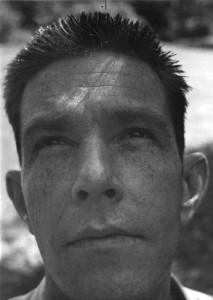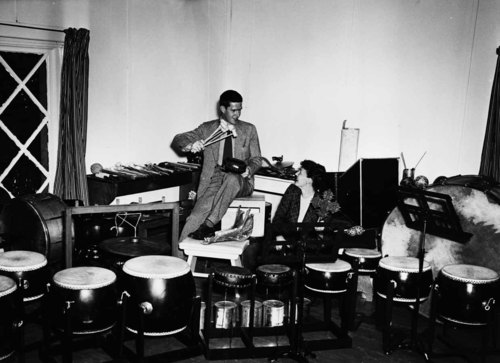[This is part of the series Opening the door into emptiness]
In February of 1948, John Cage was invited to speak at the National Inter-Collegiate Arts Conference at Vassar College. The conference subject was “The Creative Arts in Contemporary Society,” and according to accounts in the Vassar Chronicle, Cage spoke on the “reasons and ends of modern creativity.” The text of the lecture itself was hidden for years, unpublished for over four decades. It turns out to be critical to understanding Cage: it is probably the most in-depth view of him as a person to be found in his writings. I can’t help but believe that the frankness and personal nature of the lecture contributed to his having kept it out of public view for so long.
Cage titled his lecture “A composer’s confessions,” an echo of St. Augustine’s Confessions. Both works are autobiographical accounts that describe being lost and then finding the way. Cage’s lecture is a history of his personal life in music. It contains passages describing technical matters of composition; it also contains poignant descriptions of his own emotional and spiritual responses to his role as a musician in the world.
Cage describes the unhappiness caused by his professional ambition, its failed realization, and the resulting disappointment. He speaks of his ambition with the knowing tone of one who has learned better. Early on, he describes his attraction to modern art and music as “immediate and enthusiastic, but not humble: I decided that if other people could make such things, I could too.” From such a naive beginning, however, Cage developed into a driven, charismatic innovator, crusading for new music made from new sounds. He describes the accomplishments of the 1930s and early 1940s that have since become part of musical history: his contacts with Henry Cowell and Arnold Schoenberg; his innovations in percussion music and structural rhythm; his work in the radio studio of the Cornish School; his invention of the prepared piano. Cage tells the story of how he went from being an unknown, who had to write music for amateurs in order to get his music played, to a noted composer whose trailblazing work brought him before larger and larger audiences.
His dreams grew bigger. He describes his desire to establish a Center of Experimental Music:
This Center was to be a place where the work with percussion could continue, and where it would be supplemented by the results of close collaboration between musicians and sound engineers, so that the musical possibilities might be continually refreshed with new technological instruments. Composers were to be regularly advised of the new instruments available, and performances were to be periodic.
Cage saw the Center as his own personal paradise, attended by all the technical know-how necessary to realize his sonic dreams. It was the summit of his ambitions.
Disappointment followed quickly. He was unable to get anyone interested in funding his Center. He tells the story of two hours spent with the head of the Sound Department at MGM:
He showed me a room provided with a library of sound recorded on film and all the auxiliary equipment … with which a composer could compose music exactly as a painter paints pictures, that is, directly. I begged to be allowed to use this room for a few hours a day. But that was impossible, considering the objectives of Hollywood: the doors were closed.
A more devastating blow came in 1942, after Cage had moved to Chicago. CBS commissioned him to write the score for Kenneth Patchen’s radio play The city wears a slouch hat. Cage would have the opportunity to work with real engineers in a well-funded studio. His enthusiastic vision let loose at last, he wrote a 250-page score for an orchestra of instruments “the existence of which I only guessed.” When he showed it to the engineers, they just shook their heads and sent him back to compose a piece for his usual percussion instruments. Cage began to doubt his dreams: “they said it was utterly impractical and could not be done, which indeed was true.”
Cage admits that “trying to establish the Center of Experimental Music had made me ambitious,” and that “the natural outcome of this was to come to New York which is the center and the market-place.” He found no backers there, either. CBS would have nothing more to do with him. Short of funds, he sold his collection of percussion instruments. He scaled back his ambitions. He began writing mainly for the more modest medium of prepared piano. He sought the personal and the quiet: “My feeling was that beauty yet remains in intimate situations; that it is quite hopeless to think and act impressively in public terms.”
At this point in his confessions, Cage introduces himself as a seeker of wisdom. Disillusioned in New York, he turned away from the world, looked inward, and began a search for meaning. By 1948, he was composing the Sonatas and interludes, writing small pieces but asking big questions:
They have all been written in my new apartment on the East River in Lower Manhattan which turns its back to the city and looks to the water and the sky. The quietness of this retreat brought me finally to face the question: to what end does one write music?
He cites composers Lou Harrison and Merton Brown as his fellow questioners, and he identifies the two figures who would lead them on their search: Ananda K. Coomaraswamy and Gita Sarabhai.
Read the next post in this series: 2 — The purpose of music



Pingback: John Cage's silent piece(s): "Silent prayer", the first silent piece - James Pritchett